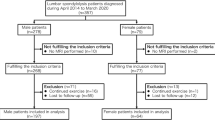Abstract
Study design
Case series and a biomechanical study using a finite element (FE) analysis.
Objectives
To report three cases with multi-level spondylolysis and to understand the mechanism biomechanically.
Background
Multi-level spondylolysis is a very rare condition. There have been few reports in the literature on multi-level spondylolysis among sports players.
Methods
We reviewed three cases of the condition, clinically. These patients were very active young sports players and had newly developed fresh L4 spondylolysis and pre-existing L5 terminal stage spondylolysis. Thus, we assumed that L5 spondylolysis may have increased the pars stress at the cranial adjacent levels, leading to newly developed spondylolysis at these levels. Biomechanically, we investigated pars stress at L4 with or without spondylolysis at L5 using the finite element technique.
Results
L4 pars stress decreased in the presence of L5 spondylolysis, which does not support our first hypothesis.
Conclusions
It seems that multi-level spondylolysis may occur due to genetic and not biomechanical reasons.







Similar content being viewed by others
References
Albanese M, Pizzutillo PD (1982) Family study of spondylolysis and spondylolisthesis. J Pediatr Orthop 2:496–499
Fredrickson BE, Baker D, McHolick WJ, Yuan HA, Lubicky JP (1984) The natural history of spondylolysis and spondylolisthesis. J Bone Joint Surg Am 66:699–707
Fujii K, Katoh S, Sairyo K, Ikata T, Yasui N (2004) Union of defects in the pars interarticularis of the lumbar spine in children and adolescents. J Bone Joint Surg Br 86:225–231. doi:10.1302/0301-620X.86B2.14339
Goel V, Grauer J, Patel T, Biyani A, Sairyo K, Vishnubhotla S et al (2005) Effects of charite artificial disc on the implanted and adjacent spinal segments mechanics using a hybrid testing protocol. Spine 30(24):2755–2764. doi:10.1097/01.brs.0000195897.17277.67
Haukipuro K, Keränen N, Koivisto E, Lindholm R, Norio R, Punto L (1978) Familial occurrence of lumbar spondylolysis and spondylolisthesis. Clin Genet 13(6):471–476
Laurent LE, Osterman K (1969) Spondylolisthesis in children and adolescents: a study of 173 cases. Acta Orthop Belg 35:717–727
Miyagi S, Yano T, Ikari T, Hirakawa S (1967) Survey on familial background of spondylolysis. Seikei Geka (Japanese) 18(1):32–37
Ravichandran G (1980) Multiple lumbar spondylolyses. Spine 5:552–557
Sairyo K, Biyani A, Goel VK, Leaman D, Booth R, Thomas J et al (2005) Pathomechanism of ligamentum flavum hypertrophy: a multidisciplinary investigation based on clinical, biomechanical, histological, and biological assessments. Spine 30(23):2649–2656. doi:10.1097/01.brs.0000188117.77657.ee
Sairyo K, Goel VK, Faizan A, Vadapalli S, Biyani S, Ebraheim N (2006) Buck’s direct repair of lumbar spondylolysis restores disc stresses at the involved and adjacent levels. Clin Biomech (Bristol, Avon) 21(10):1020–1026
Sairyo K, Goel VK, Masuda A, Biyani A, Ebraheim N, Mishiro T et al (2005) Biomechanical rationale of endoscopic decompression for lumbar spondylolysis as an effective minimally invasive procedure—a study based on the finite element analysis. Minim Invasive Neurosurg 48:119–122. doi:10.1055/s-2004-830223
Sairyo K, Goel VK, Masuda A, Vishnubhotla S, Biyani A, Ebraheim N et al (2006) Three dimensional finite element analysis of the pediatric lumbar spine. Part II: biomechanical change as the initiating factor for pediatric isthmic spondylolisthesis at the growth plate. Eur Spine J 15:930–935. doi:10.1007/s00586-005-1033-0
Sairyo K, Goel VK, Vadapalli S, Vishnubhotla S, Biyani A, Ebraheim N et al (2006) Biomechanical comparison of lumbar spine with or without spina bifida occulta. A finite element analysis. Spinal Cord 44(7):440–444
Sairyo K, Katoh S, Sasa T, Yasui N, Goel VK, Vadapalli S et al (2005) Athletes with unilateral spondylolysis are at risk of stress fracture at the contra-lateral pedicle and pars interarticularis: a clinical and biomechanical study. Am J Sports Med 33(4):583–590. doi:10.1177/0363546504269035
Sairyo K, Katoh S, Takata Y, Terai T, Yasui N, Goel VK et al (2006) MRI signal changes of the pedicle as an indicator for early diagnosis of spondylolysis in children and adolescents. A clinical and biomechanical study. Spine 31:206–211. doi:10.1097/01.brs.0000195161.60549.67
Sakai T, Sairyo K, Takao S, Hirohashi N, Higashino K, Katoh S et al (2007) Incidence of spondylolysis in Japanese population. Tokushima Spine Conference, Tokushima
Sakai T, Yamada H, Nakamura T, Nanamori K, Kawasaki Y, Hanaoka N et al (2006) Lumbar spinal disorders in patients with athetoid cerebral palsy: a clinical and biomechanical study. Spine 31(3):E66–E70. doi:10.1097/01.brs.0000197650.77751.80
Sakamaki T, Katoh S, Sairyo K (2002) Normal and spondylolytic pediatric spine movements with reference to instantaneous axis of rotation. Spine 27(2):141–145. doi:10.1097/00007632-200201150-00004
Tower SS, Pratt WB (1990) Spondylolysis and associated spondylolisthesis in Eskimo and Athabascan populations. Clin Orthop Relat Res 250:171–175
Wiltse LL, Wildell EH Jr, Jackson DW (1975) Fatigue fracture. The basic lesion in isthmic spondylolisthesis. J Bone Joint Surg Am 57:17–22
Young KJ, Koning W (2003) Spondylolysis of L2 in identical twins. J Manipulative Physiol Ther 26(3):196–201. doi:10.1016/S0161-4754(02)54133-6
Author information
Authors and Affiliations
Corresponding author
Rights and permissions
About this article
Cite this article
Sairyo, K., Sakai, T., Yasui, N. et al. Newly occurred L4 spondylolysis in the lumbar spine with pre-existence L5 spondylolysis among sports players: case reports and biomechanical analysis. Arch Orthop Trauma Surg 129, 1433–1439 (2009). https://doi.org/10.1007/s00402-008-0795-3
Received:
Published:
Issue Date:
DOI: https://doi.org/10.1007/s00402-008-0795-3




